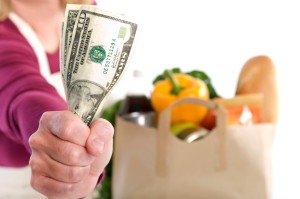
When people tell me they cannot afford organic produce or healthy cuts of meat, I ask them to consider the gargantuan markup of many convenience foods. Manufacturers package them in “value-priced jumbo sized” containers and grocery stores promote them with price cuts to create the illusion we are getting value.
When people tell me eating healthy is expensive, I ask them to factor in what they spend on designer coffees, bodegas, grab-and-go meals, and other conveniences that might spare them a little time but at the expense of their health.
Relying on inexpensive, overly processed food is tempting given our demanding lives and schedules, but the cost is quite large.
In the bigger picture, that “value menu” is anything but a value.
You Don’t Need to Spend Half Your Paycheck to Eat Healthy
Even if time and money aren’t on your side, you can still eat healthy. This is one of the most common misconceptions I hear. I understand the challenges of trying to eat well with limited financial resources, limited time, or both. But you don’t have to be rich or retired to eat well and take care of yourself.
Dispelling 3 “Healthy Eating on a Budget” Lies
The food industry spends billions of dollars each year and has become incredibly crafty at convincing us that sugary, processed foods are a real value. Let’s look at three of their myths and consider the truth about eating healthy.
1. Healthy food costs more.
Research shows eating healthy, whole, real food isn’t necessarily more expensive than eating junk food, fast food, processed foods, or convenience foods. In fact, the top four things purchased in supermarkets are ALL drugs: sugar, caffeine, nicotine, and alcohol! If you give up those “drugs,” your grocery bill will go down dramatically.
2. Healthy food is hard to find.
You don’t have to shop in a gourmet food store, a health-food store, a farmer’s market, or eat only organic to eat well. There are plenty of healthy foods right in your local supermarket. Just shop around the outside aisles of the store. Another convenient way to access healthy food is online.
3. Healthy food takes lots of time to prepare.
You don’t have to spend hours cooking complex meals to eat well. Good quality, fresh food is easy to prepare and enjoy once you learn how.
10 Strategies to Eat Well on a Budget
Ultimately, it is up to us to take control of our kitchens and our lives. The most radical message we can send the food industry – which considers money, not our health in regard to its bottom line – is to prepare our own meals, make the best food selections within our budgets, and reclaim our health.
This does not mean turning bargain food shopping into a second hobby. We are all overworked, overstressed, and overtaxed. Most of us don’t have time to scrupulously compare store prices or cut coupons.
Even so, there are ways of making choices that work within our resources. Here are 10 ideas based on how I save time and money AND create better health for myself.
1. Keep a journal.
This might be the most eye-opening experience you will encounter to better budget your time, resources, and money. For just one week, keep a journal of every cent you spend and how you spend every hour of the day. Think of money as your life energy. It represents your time in physical form. How do you want to spend this life energy?
2. Choose three things that give you more money.
For example, don’t buy that $2.00 coffee every day — that’s $730.00 a year! Likewise, you might find yourself gravitating to the vending machine daily. You can put that money towards much better use.
3. Buy in season.
You will almost always get fresher produce, probably locally grown, for less money, when it is in season.
4. Order staples online.
Why pay retail for healthy kitchen staples like turmeric, coconut oil, and almond butter?
5. Frequent discount grocery stores.
Search out cheaper sources of fresh, whole foods in your neighborhood. My top choices are stores like Trader Joe’s and shopping clubs like Costco or Sam’s Club, where you can buy vegetables, olive oil, fruits, nuts, canned beans, sardines, and salmon at much lower prices than regular supermarkets or other retail chains.
6. Think about joining your local food co-op.
Co-ops are community-based organizations that support local farmers and businesses and allow you to order foods and products in bulk at just slightly over the wholesale price. This takes a bit of advance planning but will save you money.
7. Join a community-supported agriculture program.
Buy direct and cut out the middleman. We get organic, mostly seasonal, local vegetables at a farmer’s market a mile from our house. Their prices are often half of what we’d pay at the grocery store.
8. Keep some basics on hand.
Develop a repertoire of cheap, easy-to-prepare meals. Have the ingredients available at home at all times so you don’t get stuck eating food that doesn’t make you feel well or help you create the health you want. This takes planning but is well worth it.
9. Create a “potluck club”.
Have coworkers share the responsibility of making lunch for the group once a week or every two weeks. No more buying lunch out, and you get to eat real, whole fresh food and only have to cook a few times a month.
Or create a “supper club” with a group of friends; rather than go out to dinner, once a week or once a month rotate dinner parties at one another’s homes. You will build community and health at the same time.
10. Learn the Dirty Dozen.
Not everyone has the budget to buy 100 percent organic, but the more you can, the more you will avoid GMOs and have better health. To learn the most and least pesticide-ridden foods, visit this link.






Add comment